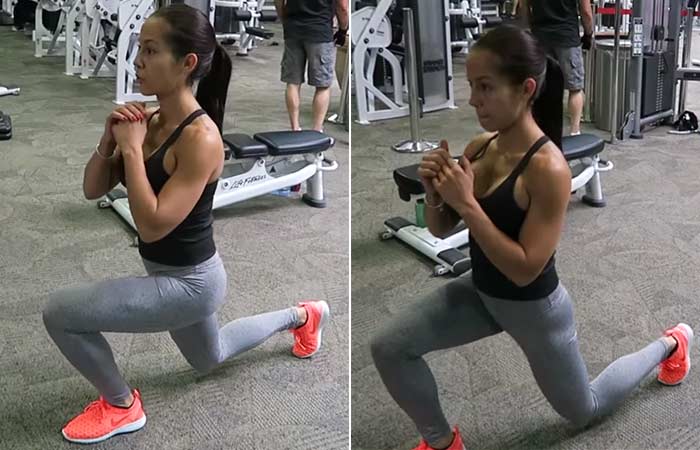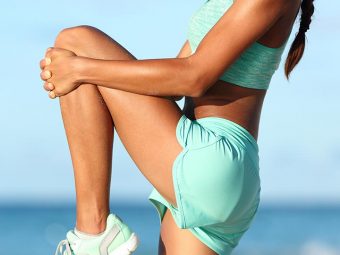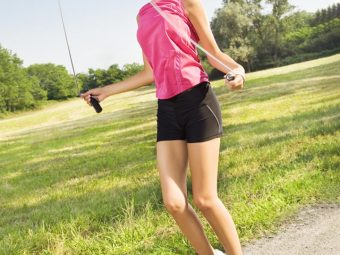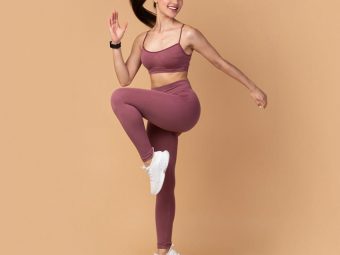7 Benefits Of Walking Lunges
Getting a strong and toned lower body is guaranteed with this single exercise.

Image: Shutterstock
If you want a toned and strong lower body, do walking lunges. As a modified version of regular lunges, walking lunges have many benefits.
According to the survey reports by National Center for Health Statistics, 46.9% of adults met the recommended aerobic physical activity as per the Physical Activity Guidelines. 24.2% of adults met both aerobic and muscle-strengthening activity.
This exercise helps tone thigh muscles, boosts strength and flexibility, improves hip and core stability, enhances balance, and leads to improved athletic performance.
Read on to know the benefits of walking lunges, how to do them, and the muscles this exercise targets.
 Workout Blueprint: Walking Lunges
Workout Blueprint: Walking Lunges- Frequency: Daily
- Benefits: Improve balance, posture, lower body endurance, and core stability.
- Equipment Needed: Dumbbells
- Space Required: Large area
- Assistance Required: No
- Who Should Avoid: Anyone with a history of back pain, knee pain, spine problems, or mobility issues.
In This Article
Types Of Lunges
- Stationary Lunges

The stationary lunge includes a downward movement that involves a strong eccentric contraction of the hams, quads, and glutes.
This ensures that the entire weight of the body falls on the forward leg. The leg that trails (the backward leg) provides balance and support to the body.
During the upward movement, both the legs take the pressure to push the body back to the standing position.
- Walking Lunges

In the walking lunge, the downward movement remains the same, with the same pressure being put on all the leg and thigh muscles. However, the upward movement is different.
All the focus is on the forward leg. All the muscles of the forward leg are contracted maximally in the attempt to stand straight again. One needs stability while performing this exercise.
- Walking Lunges With Weight

In this, all the movements are the same as that in walking lunges. You need to hold a dumbbell in each hand while doing this exercise.
 Quick Tip
Quick TipWhat Muscles Do Walking Lunges Work?
Muscles worked in lunges involve the core, butt, and legs. Walking lunges work on the following muscles and muscles groups:
- Gluteal muscles
- Hamstring
- Quadriceps
- Calves
- Core muscles
- Back muscles
In the following section, we have given you a step-by-step guide to perform walking lunges. Take a look.
How To Do Walking Lunges
- Stand by keeping your feet hip-width apart.
- Place your hands on your hips or by your sides.
- Put your right leg forward.
- Bend both knees to lower your body toward the ground. Your right knee should be directly above your right ankle while your left knee should hover just above the floor.
- Get back up by pushing your right heel, and step your left foot forward to continue the walking lunge.
- Repeat the lunge movement with your left leg now. Keep your back straight, chest up, and gaze forward.
- Perform 2 to 3 sets of 10 to 12 walking lunges on each leg.
- Inhale as you step forward and begin the lunge, and exhale as you return to the starting position.
Benefits Of Walking Lunges
Walking lunges benefits include:
1. Improve Balance
A workout based on lunges works both sides of the body, making it a unilateral exercise, which is best for improved coordination and balance (1). Exercises like squats and dead-lifts cannot provide similar results.
2. Boost Functionality
Walking lunges train the body in such a way that its functionality improves many folds. They also help one acquire a better body posture (2).
3. Aid Symmetrical Toning
Since walking lunges concentrate on the ignored parts of the body, they can help you achieve a symmetrically toned body. Walking lunges workouts take care of body parts that other exercises tend to overlook.
A study on soccer players showed that practicing forward lunges helped to strengthen hamstring muscles and improved the running speed (3).
4. Boost Hip Flexibility
Walking lunges boost the flexibility of the hip flexor muscles, which tend to become tight due to the sedentary lifestyle we lead (4).
Apart from stretching exercises, lunges are a remarkable way to impart flexibility to the hip and thigh muscles (1).
5. Tone The Gluteal Muscles
The gluteal muscles are mostly left unutilized during regular workouts. Walking lunges can help focus on glute activation and also mobilize them with regular practice (2).
6. Improve Core Stability
Standing unilateral exercises (all forms of lunges) help to strengthen the core and improve stamina (5). They help to strengthen the core muscles with their up and down motion.
7. Provide Rest For The Spine
While most forms of exercise would leave your back strained, walking lunges tend to provide rest and recovery to your spine. If you are into heavy workouts and weight training, walking lunges can be the perfect way to rest your spine (6).
Note: Walking lunge is one of the best exercises for sportspersons. It improves leg endurance, overall lower limb strength, and the firing pattern of the glutes and the hams.
Precautions
- As walking lunges require more balance and coordination, there are chances of you falling. To reduce risk of injury, concentrate on your breathing and practice walking lunges under proper supervision.
- Keep your spine and upper body erect while performing walking lunges. Do not lean forward.
- Engage your core and balance your torso and hip while doing this total body workout.
 Quick Tip
Quick TipInfographic: 5 Reasons To Embrace Walking Lunges
Walking lunges can be strenuous, which is why many people avoid doing them. Although this exercise may look relatively simple, it can be deceptively difficult. It is a powerhouse of functional fitness that strengthens the muscles and improves your overall performance. Check out the infographic below to know why you should include this exercise in your workout routine.

Illustration: StyleCraze Design Team
Save the high-quality PDF version on your device now.
Download Infographic
Walking lunges target the glutes, hamstrings, calves, quadriceps, core, and back to strengthen the lower body and can give you improved balance, stability, and coordination. It can help you achieve increased mobility, especially in the hip and leg muscles. Additionally, it can also give you improved joint flexibility, increased muscular endurance, improved lower body endurance, and enhanced functional movement patterns. The other benefits of walking lunges, a modified version of regular lunges, include improved functionality, bad body posture, and hip flexibility. This workout can lead to increased calorie burn and contribute to weight loss or weight management goals. Remember that while walking lunges can provide some cardiovascular benefits, they are not typically considered a cardiovascular workout on their own. Practice caution while doing walking lunges as you may risk falling if you don’t have a good balance and coordination. Also, focus on your form and keep your spine erect and straight. Consult a doctor or a physiotherapist to find out if it is safe for you to do walking lunges and come up with what is best for you.
Frequently Asked Questions
Can you do walking lunges every day?
Yes, you can do walking lunges every day under proper supervision. However, perform different combinations of exercises for improved body composition and better results.
How many sets of walking lunges should I do?
You can do 10-20 repetitions with 2-3 cycles. If you are a beginner, start slowly and increase the pace gradually.
Do walking lunges make your thighs bigger?
Walking lunges help tone up thigh muscles. If you want bigger thighs, combine lunges with other forms of exercise and lift weights.
How long does it take to see results from lunges?
Lunges, when performed the right way and consistently, can show you visible results in 2 to 6 weeks.
Why do walking lunges hurt so much?
In comparison to lunges, walking lunges are more physically demanding and challenging. Their advanced difficulty also makes an individual susceptible to poor posture while performing the exercise, which further causes pain.
Should my knee touch the ground during walking lunges?
No, your knee should not touch the ground while performing walking lunges. Maintain good form and balance and keep your knee aligned with your ankles while you perform this exercise (1).
Key Takeaways
- Walking lunges in your workout routine can improve the body’s balance and coordination.
- It also helps tone and strengthen your glutes.
- It increases the core strength of the body and improves stamina.
- A simple tip to perfecting your walking lunges is to focus on your breathing. This can also help you avoid injuries.
Sources
Articles on StyleCraze are backed by verified information from peer-reviewed and academic research papers, reputed organizations, research institutions, and medical associations to ensure accuracy and relevance. Read our editorial policy to learn more.
- Balance and Lower Limb Muscle Activation between In-Line and Traditional Lunge Exercises Journal of Human Kinetics US National Library of Medicine National Institutes of Health
https://www.ncbi.nlm.nih.gov/pmc/articles/PMC6006536/
Check out the video below and discover the incredible transformational power of lunges. Witness how incorporating lunges into your workout routine can reshape your body over a transformative 30-day period.
Sources
- Balance and Lower Limb Muscle Activation between In-Line and Traditional Lunge Exercises, Journal of Human Kinetics, US National Library of Medicine, National Institutes of Health.
https://www.ncbi.nlm.nih.gov/pmc/articles/PMC6006536/ - Does the Dumbbell-Carrying Position Change the Muscle Activity in Split Squats and Walking Lunges? Journal of Strength and Conditioning Research, US National Library of Medicine, National Institutes of Health.
https://www.ncbi.nlm.nih.gov/pmc/articles/PMC4640053/?report=classic - Forward lunge: a training study of eccentric exercises of the lower limbs, Journal of Strength and Conditioning Research, US National Library of Medicine, National Institutes of Health.
https://www.ncbi.nlm.nih.gov/pubmed/19387378 - Hip-muscle activation during the lunge, single-leg squat, and step-up-and-over exercises, Journal of Sport Rehabilitation, US National Library of Medicine, National Institutes of Health.
https://www.ncbi.nlm.nih.gov/pubmed/19321909 - Muscle activity of the core during bilateral, unilateral, seated and standing resistance exercise, European Journal of Applied Physiology, US National Library of Medicine, National Institutes of Health.
https://www.ncbi.nlm.nih.gov/pubmed/21877146/ - Spinal-Exercise Prescription in Sport: Classifying Physical Training and Rehabilitation by Intention and Outcome, Journal of Athletic Training, US National Library of Medicine, National Institutes of Health.
https://www.ncbi.nlm.nih.gov/pmc/articles/PMC5094840/?report=classic


























